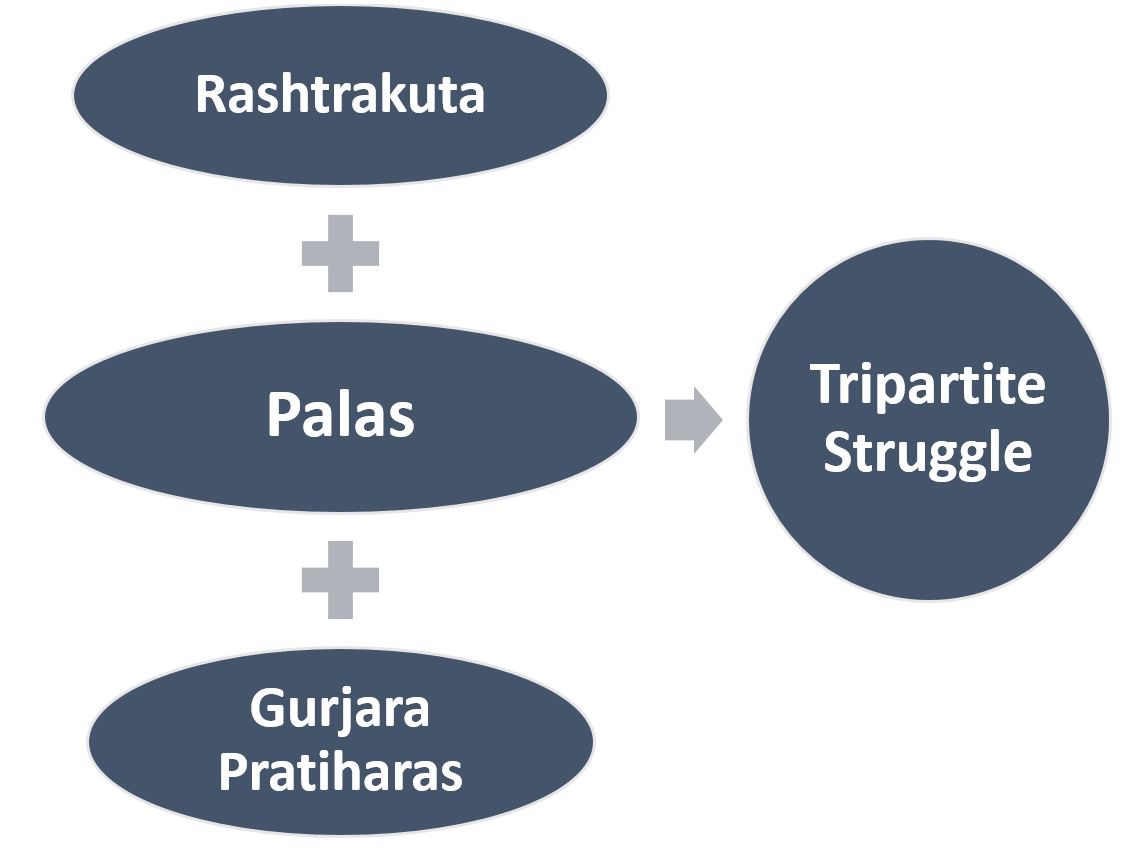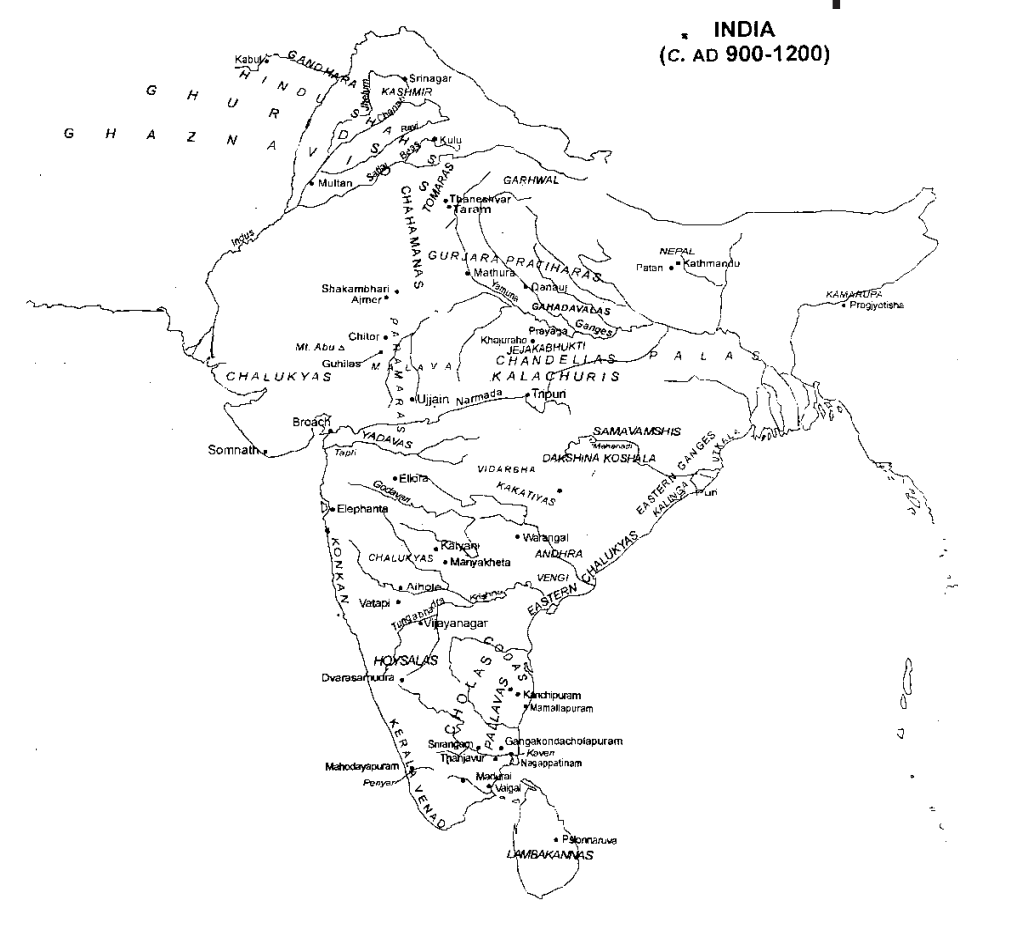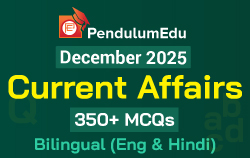Kingdoms of Early Medieval Period | Tripartite Struggle | Chola Empire | Rajputs
The period between AD 750 and AD 1200 is known as the early medieval period of Indian History. Earlier, it was called the ‘dark phase’ of Indian History due to numerous fights between regional states. The recent studies show that though India was politically divided, it witnessed remarkable growth in the field of art, literature and language.
During this period, Kannauj became more significant and Pataliputra lost its importance as a sign of the sovereignty of India. There was complete decentralization that led to Indian feudalism. The political unity of India broke down due to the emergence of many regional powers who were waging continuous wars against each other.
1. Dynasties of Early Medieval Period
The political development of this period is mainly divided into two phases. The first phase (750 AD to1200 AD) marked the rise of three important political powers in India – Gurjara Pratiharas (north India), Palas (eastern India) and Rashtrakutas (South India). The second phase (1000AD-1200AD) witnessed break-up of these powers.
1.1. Tripartite Struggle
Tripartite Struggle was an armed conflict between Palas of East, Gurjara Pratiharas of North and Rashtrakutas of South India. These powers were fighting with each other to set up their control on the Gangetic region in northern India.
The main objective of the conflict was to possess the Kannauj city, then a symbol of sovereignty.
1.1.1. Gurjara Pratiharas Dynasty
- It was founded by Nagabhatta I in the eighth century.
- They originated from the Gujarat or South western region of Rajasthan.
- Mihira Bhoja was the greatest ruler of this dynasty. He had defeated Narayanpala of Pala dynasty.
- Mahendrapala I, successor of Mihira Bhoja, expanded his territory which triggered the Tripartite Struggle.
- Due to the rise of feudal lords and internal conflicts, Pratiharas were disintegrated into many Rajput kingdoms like Chahmanas, Chandellas, Paramaras, Solankis, etc.
1.1.2. Palas
- It was founded by Gopala around 750 AD.
- The Pala kings were followers of Buddhism. They made monasteries and temples in Eastern India to promote Buddhism.
- Dharmapala created Somapura mahavira at Paharpur.
- His son Dharmapala revived Nalanda University. He was defeated by Rashtrakuta ruler Dhurva.
- Dharmapala founded Vikramashila University near Bhagalpur (Bihar).
1.1.3. Rashtrakuta Dynasty
- Dantidurga was the founder of the Rashtrakuta dynasty. Chalukyas of Badami were defeated by him.
- Capital: Manyakheta or Malkhed
- Dhruva, a Rashtrakuta ruler, turned towards north India to control Kannauj which led to the beginning of the ‘Tripartite struggle’. He defeated Palas, Pratiharas, Pallavas, and Eastern Chalukyas. He became the first Deccan king to annex Kannauj.
- Krishna I built the famous Kailasha temple at Ellora (Maharashtra). Govind-III and Amoghvarsha were the greatest Rashtrakuta ruler.
- Kavirajamarga was one of the creations of Amoghvarsha. During his reign, an Arab traveler named Abu Sulaiman visited his capital. He patronized Jainism.
- Rashtrakuta dynasty ruled over Deccan from around 800AD-1000AD.

Fig.1: Tripartite Struggle
1.2. Rise of Chola Empire
Vijayalaya was the founder of the Chola dynasty.
Chola empire was extended between river Tungabhadra in the north to Kanyakumari in the south. Chola Kings use their Navy for their foreign expedition. They conquered parts of the Maldives and Sri Lanka.
Rajaraja I and his son Rajendra I were the real architects of this dynasty. Rajaraja I is famous for constructing a famous temple known as Rajarajeshwara or Brihadesvara temple located at Tanjore. It is dedicated to Lord Shiva. He built a dam across Kaveri river.
Rajendra I defeated Mahipala I and assumed the title of “Gangai-konda” (conqueror of Ganga) and also founded a new capital called ‘Gangaikondacholapuram’.
Rajaraja II built the Darasuram Temple.
Rajendra Chola III was the last Chola ruler. Under his tenure, the empire started disintegrating into smaller regions.
1.2.1. Chola Administration
Local self-government was the basic feature of the Chola administration.
The Chola empire was divided into mandalams or provinces. These were further divided into valandu and nadu. Under nadu, there were many autonomous villages. Two types of villages were there- Ur (people from different caste and assembly) and Agrahara (settled by Brahmins). Town was called nagram.
|
Divisions |
Head |
|
Mandalam |
Royal Prince or officers |
|
Valanadu |
Periyanattar |
|
Nadu |
Nattar |
|
Nagram (Town) |
Nagarattar (Council) |
The cholas undertook land surveys and revenue settlement to assess taxes. Kuli, Ma, Patti, Veli and Padagam were some units of land measurement.
Trade and commerce were in the flourished state during the Chola empire.
Cholas were ardent followers of Shaivism. Devadasi system came into practice during this period.
1.3. The rise of Rajputs
After Harsha’s death (647 A.D.) and disintegration of Pratihara empire many Rajput states emerged in Rajasthan and Indus plain. The Gahadvalas of Kannuj, Parmars of Malwa, and Chauhan of Ajmer were the prominent Rajput rulers.
Each Rajput state was ruled by a ruler with the help of his chiefs who were generally his blood brothers.
The political system of the Rajputs was bureaucratic-cum-feudal in character.
- Prithviraj Raso (a long epic poem) written by Chand Bardai give an account of military conquests of Prithviraj Chauhan.
- The Solankis or Chalukya Dynasty ruled the Gujarat region. Under the reign of Bhimadeva I which lasted for around 42 years, Mahmud of Ghazni raided the Somnath Temple.
- Raja Bhoj was the famous ruler of the Parmar Dynasty. He built Bhojshala (a Sanskrit college) in his capital city Dharanagar.
- The Chandelas ruled the eastern part of Madhya Pradesh. Dhanga was the famous ruler of this dynasty. He adopted the title of Maharajadhiraja. Kandariya Mahadev Temple in Khajuraho complex was built by Chandelas. It is dedicated to Lord Shiva.
- The famous ruler of Gahawars or Rathors was Jaichand.
1.3.1. Important Battles fought by Rajputs
- The Rajputs led by Prithviraj Chauhan defeated Ghurids, led by Muhammad Ghori in the First Battle of Tarain in 1191.
- In 1192, Muhammad Ghori defeated and killed Prithviraj in the Second Battle of Tarain.
- In the Battle of Chandawar, Jaichand was defeated by Mohammad Ghori (1193 or 1194).
1.3.2. Causes of Decline of Rajputs
- Rajput states were engaged in constant war against each other for power which led to the wastage of their resources.
- Feudal system proved fatal for Rajput kingdoms.
- Turkish invasion weakened Rajput states.
- A stringent caste system doesn’t allow people from lower caste to join the army of Rajput state.

Fig.1: Political Map of India during 1000 to 1200 AD (Source: NIOS)
1.4. Other Important rulers of North and South India
1.4.1. Harshavardhana
- He was one of the most famous Indian rulers of the 7th century AD. His empire extended from north India to the Narmada River in central India. He was the son of founder of Vardhana or Pushyabhuti Dynasty.
- He established his capital at Kannauj.
- It was during his reign; feudalism began in India.
- The two most important events of Harsha’s reign were the assemblies at Kannauj and at Prayaga.
- Hiuen-Tsang (Xuanzang) visited Harsha’s court and provided detail about the Harsha’s administration.
- Banabhatta was a poet in Harsha’s court. He wrote ‘Harshacharita’ a biography of Harshavardhana in the Sanskrit language.
- He was defeated by a South Indian ruler Pulakeshin II (Battle of Narmada). The defeat of Harsha is mentioned in Aihole inscription.
1.4.2. Pulakesin II
- He was one of the greatest rulers of the Chalukya Dynasty of Vatapi.
- He established Vatapi or Badami as its capital.
1.4.3. Vikramaditya II
- He was the son of Vikramaditya I. He succeeded the Badami Chalukya kingdom after his father died.
- He conducted successful military campaigns against Pallavas of Kanchipuram.
- The consecration of the famous Virupaksha Temple (Lokeshwara temple) and Mallikarjuna Temple (Trilokeshwara temple) are the notable achievements of Vikramaditya II.
1.4.4. Narasimhavarman I
- He was the ruler of the Pallava dynasty from 630–668 CE.
- Famous Pancha Rathas Temple was constructed during his reign.
- He was also known as Mahamalla (great wrestler) and he defeated Chalukya king, Pulakeshin II in 642 AD.
2. Causes of Decline of Early Medieval Rulers
- Early Medieval rulers were engaged in constant war against each other. The lack of unity among various dynasties led to the decline.
- The rulers during the early medieval period did not maintain a huge army and were dependent on Feudal lords. The feudal system was another cause for the downfall.
- The rulers of the Early Medieval period followed old war techniques and used outdated weapons therefore, they could not protect their kingdoms from Turkish invasion.
- The espionage system was very weak.
- Rigid caste system caused disunity among the people.
3. Economic and Social life
Many social and economic changes were seen during the early medieval period. New groups were added to Brahmanical society.
New areas were brought under cultivation and land grants have increased. The land grant helped in the emergence of the Kayastha class.
The economic condition in the first phase (AD 750–AD 1000) was on the decline as evident from the absence of coins for exchange and the condition of towns of north India.
The economic condition in the second phase revived after 1000 AD. New gold coins were found and towns were in a good state. The revival seems to be due to an increase in agricultural activities and the emergence of Arab traders as important players in international sea trade.
3.1. Society
The emergence of a power of a class of people who were called Samanta, Ranak, Rautta, etc, can be easily seen during this period. They were either government officers or defeated ruler and their supporters.
The caste system was prominent in society. Most of the workers as well as tribals were considered untouchables. The Brahmanas enjoyed superiority in the caste system.
The ministers and the officials assumed high-sounding titles as mahasamantadhipati.
Hinduism was expanding rapidly and society has become more complex due to more sub-castes.
3.2. Condition of women
The marriage age was lowered and the education of women was in a poor state. The condition of women has degraded during this period.
Remarriage was allowed under certain conditions and widows has the Right to property.
3.3. Trade and commerce
The rate of the revenue from peasants was one-sixth of the produce. There were a number of additional cesses such as grazing tax, tax on ponds, etc.
The revenue assignment granted by the ruler to his officer was known as bhoga. They were temporary in nature.
The hereditary chiefs not only assess land revenue but also give punishment and impose fines.
Trade between South India and south-East Asia flourished during this period. The merchants were organized in guilds.
The main port for sailing to Java, Sumatra was tamralipti in Bengal.
Indian rulers Palas, Cholas, Pallavas encouraged trade with China and send their many embassies to Chinese rulers.
4. Cultural Development
- Temple architecture attained its climax under the Cholas. A style of temple architecture known as Dravida style emerged. Some of the characteristics of this style are the garbhagriha (chief deity room), the vimanas (building of storey upon storey), the mandapa and the gopurams.
- The most remarkable examples of this style were Kailashnatha at Kanchipuram and Brihadiswara temple at Tanjore.
- The greatest Sanskrit poet and dramatist Rajsekhar lived in the court of Mahipala.
- The famous rock-cut temple of Shiva at Ellora was built by Rashtrakuta king Krishna I in the 9th century.
- Under Chalukyas of Kalyani temple activities continued at Hoysalas. These temples have finely sculptured panels which show a panorama of life.
- Kannada was patronized by Rashtrakuta, Chalukyas, and Hoysala.
- Angkorvat temple is one of the most famous temples built in the 12th century that is dedicated to Lord Vishnu. Surya Varman II, the king of Kambuja (Cambodia) had built this temple. The walls of the temple are decorated with sculptures based on themes drawn from Mahabharat and Ramayana.
5. Religious movement during the period
This period is marked as a revival of Hinduism and the decline of Buddhism and Jainism.
Many internal changes occurred in Buddhism during this period.
Jainism continued to be popular among the trader’s community. The Ganga rulers of Karnataka were patrons of Jainism.
In Hinduism, Shiva and Vishnu became the chief gods. Bhakti movement in south India started during this period.
Alwars/ Alvars were devotees of Vishnu during the 6th -9th century.
Nayanars were a group of saints living in Tamil Nadu during the 3rd to 8th centuries CE. They were devotees of Shiva.
Another famous movement was Lingayat or Vir Saiva movement. They were worshippers of Shiva.
Sankara proposed Advaitavada or the doctrine of non-dualism philosophy in the 9th century.
Summary
- The period between AD 750 and AD 1200 is known as the early medieval period of Indian History.
- The first phase (750 AD to1200 AD) marked the growth of three important political powers in India and the second phase (1000AD-1200AD) witnessed the break up of these powers.
- Tripartite Struggle was an armed conflict between Palas of East, Gurjara Pratiharas of North and Rashtrakutas of South India.
- Vijayalaya was the founder of the Chola dynasty. It was extended from between river Tungabhadra in north to Kanya Kumari in south.
- Local self-government was the basic feature of the Chola administration. Rajaraja I and Rajendra I are the most important Chola rulers.
- The Rajputs led by Prithviraj Chauhan defeated Ghurids, led by Muhammad Ghori in the First Battle of Tarain in 1191. Muhammad Ghori defeated and killed Prithviraj in 1192.
- The economic condition in the first phase (AD 750–AD 1000) was on the decline.
- Emergence of a power of a class of people who were called samanta, ranak, rautta, etc. was found during this period.
- The caste system was prominent in society. Hinduism was expanding rapidly and society has become more complex.
- The rate of the revenue from peasants was one sixth of the produce. Trade between south India and south-East Asia flourish.
- Temple architecture attained its climax under the Cholas. Dravida style was the most prominent style of temples.
- The most remarkable example of this style was Kailashnatha at Kanchipuram and Brihadiswara temple at Tanjore.
- The famous rock-cut temple of Shiva at Ellora was built by Rashtrakuta king Krishna I in 9th century.
- In Hinduism, Shiva and Vishnu became the chief gods. Bhakti movement in south India started during this period.
- Harshavardhana, Pulakesin II, and Narasimhavarman I are the important rulers of this period.




 Latest
Latest 



Comments